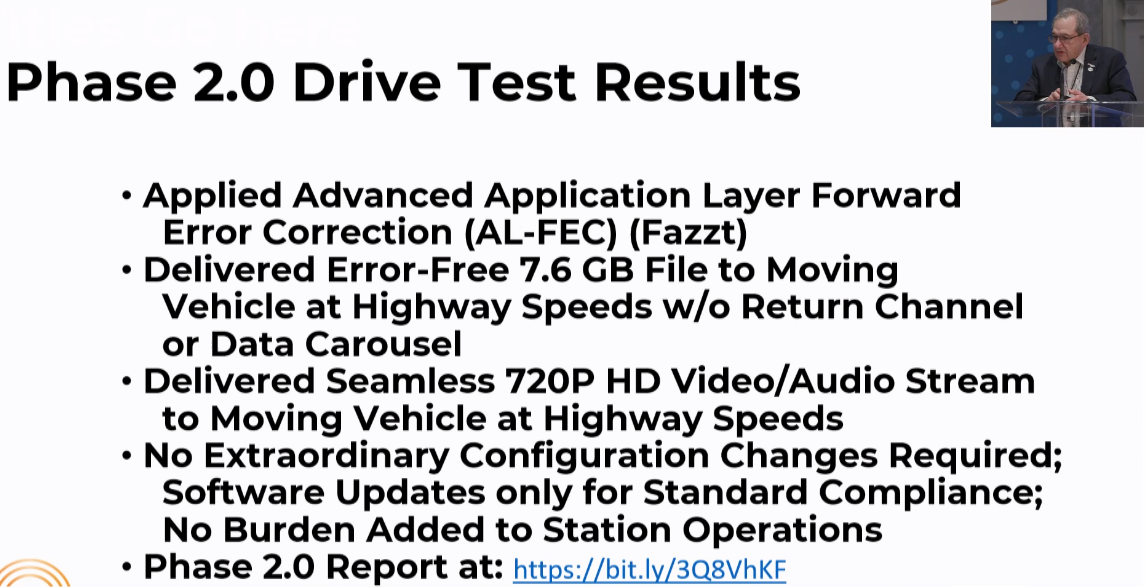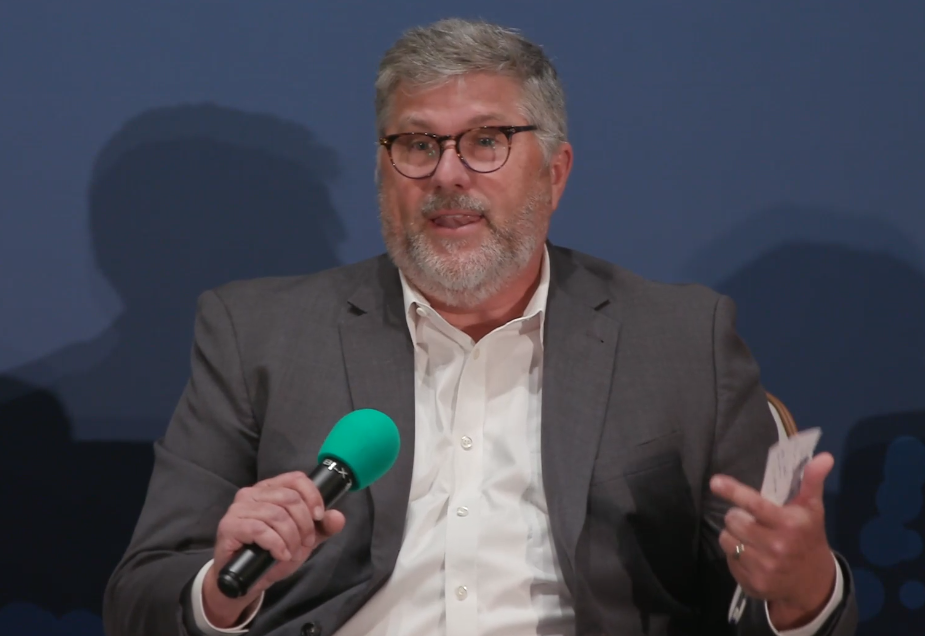ATSC 3.0 Set To Roll As Road To Use In Vehicles Becomes Clearer
While obstacles remain, the route of ATSC 3.0 to video and data delivery to autos unfolds at conference

DETROIT—To be sure, challenges remain for ATSC 3.0 in the delivery of video audio and data to vehicles, but the ATSC Next Generation Broadcast Conference June 9 clearly demonstrated robust IP data delivery to moving vehicles is technically possible and that –with the help of transportation infrastructure agencies—it may be easier to get receivers into future models of trucks and cars than previously thought.
Madeleine Noland set the theme for conference sessions when she revealed that South Korean auto parts manufacturer Hyundai Mobis has developed an ATSC 3.0 receiver for use in vehicles, completed testing of it in auto applications and that the company expects the first commercially available 3.0-enabled vehicles to be on the road in the United States next year.
While connecting cars is complicated, it’s hard to buy a car today that doesn’t have a connection, said Roger Lanctot, director of global automotive practice at Strategy Analytics, who laid out where connectivity and the automobile industry are headed.
“You've probably heard many times in the media people talking about the car as a smartphone on wheels… however, I'm here to say that the car is becoming something of a smart TV on wheels,” he said.
While delivery of entertainment content is important, connectivity’s primary role is in support of safety applications in vehicles, he said. Applications, such as updating GPS data and information about construction hazards, are only a few of the safety-related uses making reliable data delivery essential.
ATSC 3.0 has emerged at a fortuitous time in the evolution of the auto industry, he said. ““The entire industry is shifting to electric vehicle propulsion, which means vehicles are being redesigned, from the ground up blank slate and redesigned, which means everything's on the table for reconsideration. And that is why it's such a great time [for 3.0 to offer a connectivity solution for vehicles]. Such a great opportunity,” he said.
“At the end of the day, I just want to say ATSC 3.0 provides a low-cost data delivery broadcast pipe to the cars which are increasingly leveraging multimodal connectivity, and I think it's a huge breath of fresh air. It's a huge opportunity.”
Get the TV Tech Newsletter
The professional video industry's #1 source for news, trends and product and tech information. Sign up below.
Testing Proves 3.0 Vehicle Viability
During the conference consulting engineer Merrill Weiss presented findings from a three-part (phase one, one-and-half and two) “coast-to-coast” test in Michigan of 3.0 to demonstrate whether the standard is ready for data delivery to mobile receivers as well as possible future enhancements to the standard.
Before beginning the test, it was necessary to create a broadcast core network—manually operated because the automation required has not yet been developed—to manage data delivery across the four ATSC 3.0 transmitter multi-frequency network (MFN) set up for the cross-state test. The transmitting sites included one high-power, high-tower station and three low-power stations with medium-height towers, he said.
A mobile lab based on the Sony mobile reception platform was assembled for experimentation and to take measurements as it was driven coast-to-coast, said Weiss.

Phase one of the test identified gaps in signal delivery along the test route as a way “to prove the value…of diversity reception” and that it was possible to do handoffs between stations in different markets using “the signaling that is provided in ATSC A331 for transitioning between stations in multiple markets in an MFN actually worked,” he explained.
In Phase 1.5, the testers improved the algorithms needed for the handoff and improve the rejection of co-channel interference from one station to another in the network that happened to be on the same channel and happened to be immediately adjacent to another,” said Weiss. This phase also saw improvement in the algorithm used for antenna selection.
“We were able to deliver video and audio content to mobile receivers at high speed; we were able to deliver on-real-time data –in this case it was a set of photos that permitted telling whether there was a dropout during each individual, small file transmission…. There were minimal dropouts,” he said.
In phase two, the test applied an advanced Application Layer Forward Error Correction (AL-FEC) scheme and leveraged a technique called bandwidth multiplication “by using independent feeds from the source server to each of the transmitters individually,” he said. This technique effectively doubled the 1Mb/s allotted to the test to 2Mb/s by capturing the files being received and downloaded.
For data transmission, a technique that uses this advanced FEC setup and sends the same data to each transmitter in the MFN but codes each data feed differently makes it is possible to “receive about 103 to 110% of the total size of the file from any of those transmitters, any of the packets, [and] you can put together the entire file that you’re trying to transfer,” he said.
“As a consequence, if you are able to receive from multiple transmitters simultaneously, you can improve the delivery rate,” he said, adding the tests successfully demonstrated this capability. The tests showed it is possible to deliver an error-free 7.6 GB file to a moving vehicle with no return channel and without using a data carousel.
This phase also demonstrated delivery of 720p HD video with seamless switching between multiple stations as the test vehicle traveled down I-96 at highway speeds, he added.
During a Q&A, Weiss was asked about why it was necessary to employ AL-FEC rather than simply increasing the physical layer forward error correction of the Physical Layer Pipe (PLP) used to carry the data service.
The physical layer coding was optimized for various combinations of modulation and coding during the design of ATSC 3.0’s physical layer. The errors corrected with the physical layer tend to be short in duration, which in a mobile use of the standard would relate to quick signal variations related to traveling at high speeds, he said.
However, longer dropouts of data, such as those related to traveling through a tunnel, can better be addressed by FEC in the application layer with a longer buffer that can store more data before it is used. “For instance, one of the techniques that was applied in the area that I showed where we expected a dropout was to use a buffer of 1,200 seconds, 20 minutes, and as a consequence, you could go through that area and have no loss of content even though we had a significant dropout,” he explained.
While Weiss’s presentation about the test was typically analytical and thorough, Kerry Oslund, vice president of strategy and business development at The E.W. Scripps Co., who drove the test vehicle across Michigan and had no view of the test as they unfolded, recounted the excitement.

“We were getting to those moments where we knew that there was going to be a handoff, but we’ve never seen the handoff technology work,” he said during the session. “Luke [Fay, senior manager of technical standards at Sony Home Entertainment & Sound Products] was doing the play by play. And he was saying, ‘We’re getting close. We’re getting close.’ I can’t see anything because I’m driving 70 mph in a Winnebago, and all of a sudden, ‘Handoff, handoff.’ And they’re screaming, and they’re celebrating in the back, and I’m screaming and celebrating and driving the Winnebago.”
Fay also contributed his perspective on 3.0 mobile reception. “How can I give the confidence to all of you that this just works?” asked Fay. The answer was to show video taken during mobile reception tests in various cities around the country.
Playing video taken during driving tests in Santa Barbara, Calif., Phoenix and Detroit, Fay set up the clips explaining that two systems—a four- and one-diversity antenna system—were used and video from each shown on monitors built into the back of the headrests of the front seats. The one-diversity antenna system had the antenna positioned at the front of the test vehicle, while the other system had antennas located around it.
Overall, they showed seamless playback of received 3.0 video with no special software setup, just “a dedicated pipe operating at 5 dB SNR,” he said, adding “it just simply worked.”
Inside a tunnel in Phoenix, the video showed, the four-diversity system continued to work “for quite a ways” while the other system did not, he said.
During the session, Robert Foster, president and CEO of Auton, discussed the company’s participation in testing at the Motown 3.0 Test Track at the invitation of Scripps and Pearl TV as well as its approach to using two levels of forward error correction, one on the physical layer and the other that borrows from a technique used on the internet to compensate for packet loss stemming from buffer overflow but in the case of mobile 3.0 is used to recover lost packets over a longer timeframe.
Accelerating Mobile Adoption
The NextGen Broadcast Conference may have demonstrated that automakers are ready for a major rethink of just about everything as they begin designing electric vehicles from the ground up and the ability of 3.0 to execute robust delivery of data, video and audio to moving vehicles on highways and surface streets as well as in tunnels, but questions remain about how best to motivate their adoption of ATSC 3.0 reception in vehicles.
John Lawson, executive director of the AWARN Alliance, may have the answer. During another conference session, Lawson advised the broadcast industry to focus on explaining the benefits of 3.0 data delivery to “infrastructure players as well as automakers.”
Those infrastructure players include the state transportation agencies that are writing the specification for communications to future smart vehicles. “You have to work with these public sector agencies,” he said.
The future of Intelligent Transportation System (ITS) communications suffered “a major setback” last year when the FCC voted to take away half of the spectrum allocated for communicating safety information to smart vehicles, such as the presence of stopped cars at a red light or that a car is rolling into an intersection, he said.
“ITS has a major vulnerability that we can address,” said Lawson. The idea that broadcasters can reach all cars from a tall tower is interesting to the ITS community.
The AWARN executive director also noted that now is the time to accelerate efforts to raise the awareness of state public transportation agencies about 3.0 because a new ITS communications ecosystem is needed. “3.0 could be part of that,” he said, adding that there has been a “massive infusion of federal money for smart transportation,” including services to communicate evacuation instructions in the event of an emergency, something well-supported in the NextGen TV standard.
Phil Kurz is a contributing editor to TV Tech. He has written about TV and video technology for more than 30 years and served as editor of three leading industry magazines. He earned a Bachelor of Journalism and a Master’s Degree in Journalism from the University of Missouri-Columbia School of Journalism.

